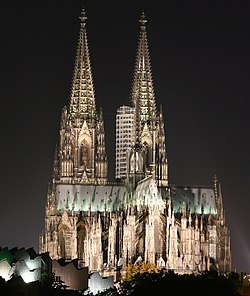
This is the list of cathedrals in Germany sorted by denomination.
Contents
Some pre-Reformation cathedrals in Germany, now within one of the Lutheran or united Protestant churches (co-operating in their umbrella organisation Protestant Church in Germany) still retain the term cathedral, despite the churches Presbyterian polity which does not have bishops (in some Protestant churches) or use the term as a merely honorary title and function, void of any hierarchical supremacy. As cathedrals are often particularly impressive edifices, the term is often used incorrectly as a designation for any large, important church. This is especially true in Berlin, where three Protestant church buildings, which never functioned as cathedrals, are colloquially called cathedral, and Frankfurt Cathedral (German: Dom; cf. Berliner Dom, Deutscher Dom and Französischer Dom, Kaiserdom).





